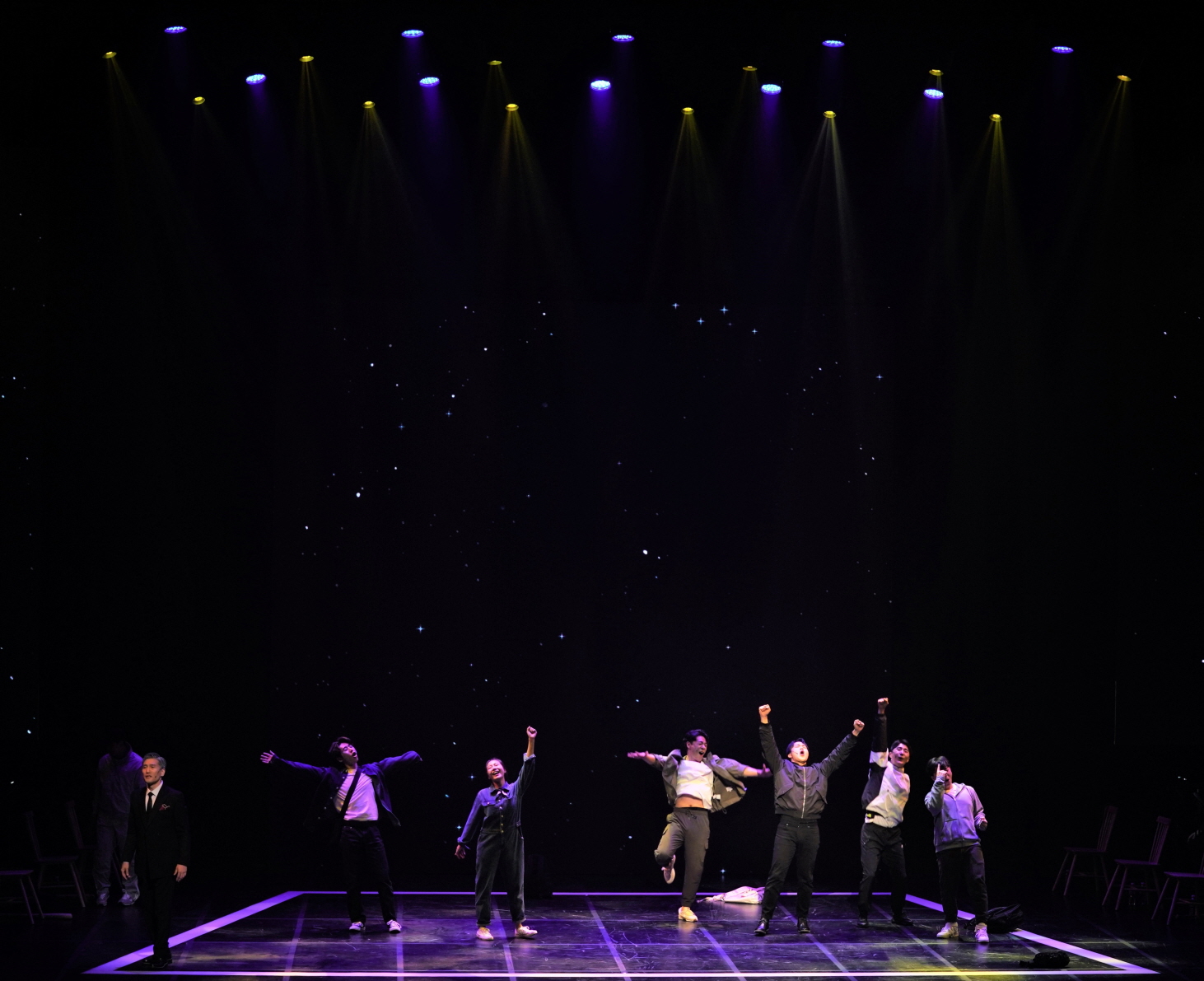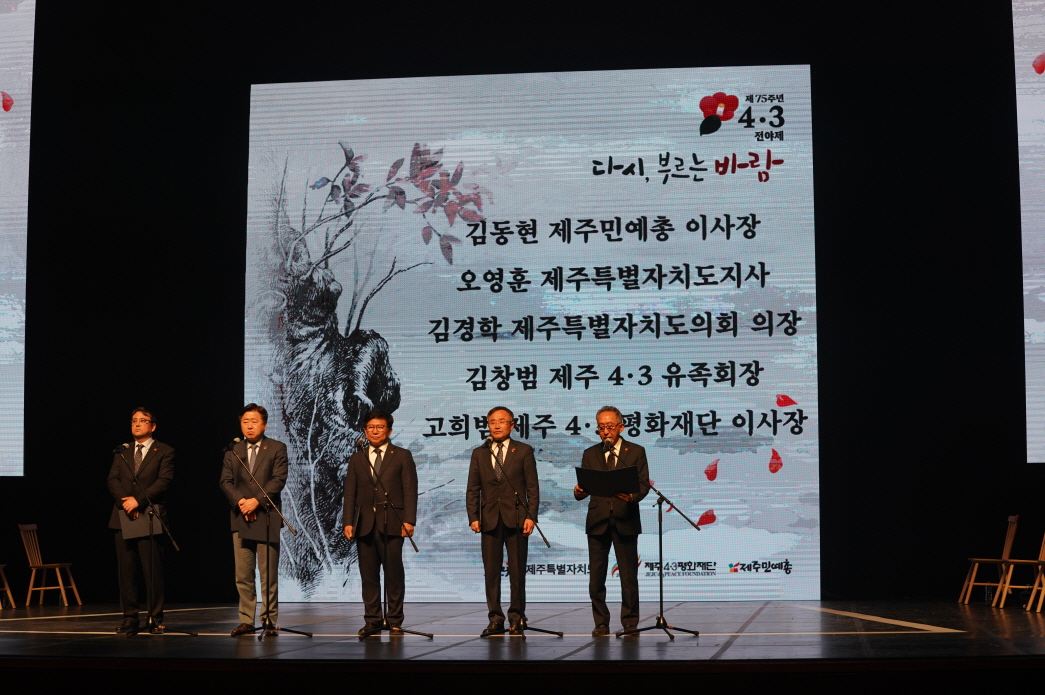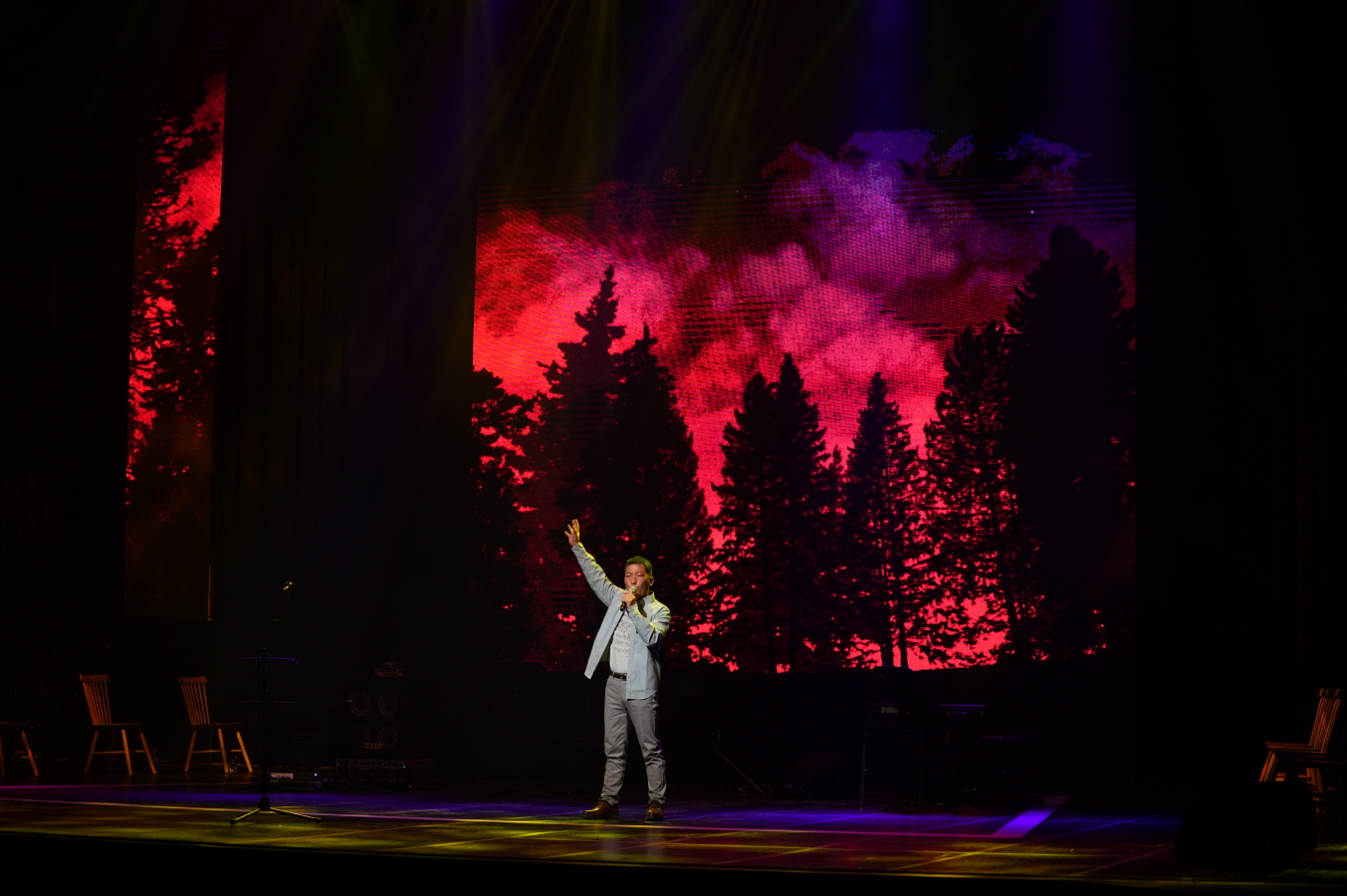Evening Event of Memorial Ceremony for Jeju 4·3 Victims – Again, The Wind Blows
Rooting for ‘Jeju 4·3 arts,’ which is at the forefront of the struggle for memory
Han Hyeong-jin
Culture Desk Writer, The Jeju Sori
 ++ The musical team for “The Great April” gives a greeting onstage.
++ The musical team for “The Great April” gives a greeting onstage.
The outdoor yard of Jeju Culture and Art Center at 7 p.m. on March 31, 1994. The unconventional poster of the inaugural Jeju 4·3 Art Festival shows a bull’s eye marked on Jeju Island. The beginning date of the festival is printed at the bottom of the poster.
The Evening Event of the Memorial Ceremony for Jeju 4·3 Victims was started in 1994 by the Jeju People Artists Federation (former Jeju branch of the Korean Federation of People’s Arts Organizations). The annual art fair is held around April 3 and marks its 30th anniversary this year.
“Initially, the evening event (organized by the Jeju People Artists Federation) consisted of Chohongut [a shamanic ritual to invoke the spirits of the dead] and Madanggut [a shamanic ritual to send off the invoked spirits] performed in Gwandeokjeong Square. A few years later, Georigut [a shamanic ritual performed in neighborhood streets] was added to the process. Now, Chohongut takes place in front of Jeju City Hall, while Georigut is led by various culture and art organizations, victims’ families, and civic groups along the street from Nammun Rotary and Jungang Rotary to Gwandeokjeong Square, where Madanggut is finally performed. This outline of the evening event has been formalized to reflect Jeju Island’s long shamanic tradition from a contemporary perspective.”
– From An Introduction to the Jeju 4·3 Cultural Movement as a Struggle for Memory in “Progression of the Struggle for Memory and Cultural Movement”
 ++ The musical team performs “The Great April” onstage.
++ The musical team performs “The Great April” onstage.
As Kim Yeong-beom, professor emeritus at Daegu University (current president of the Jeju 4·3 Research Institute) explains, the Evening Event of the Memorial Ceremony for Jeju 4·3 Victims starts with activities on the streets. The Jeju 4·3 movement has gradually experienced institutional changes in the course of the enactment of the Jeju 4·3 Special Act (2000), the designation of April 3 as a national memorial day (2014), and the revision of the Jeju 4·3 Special Act to include clauses on national compensation and retrials for the victims. Likely, changes have been made to the Evening Event of the Memorial Ceremony for Jeju 4·3 Victims as well.
The event has been held both indoors and outdoors, in the Outdoor Grand Theater of the Jeju Culture and Art Center, the front yard of Gwandeokjeong Pavilion, the square in front of Jeju City Hall, and the Jeju Arts Center. The content and genres have also changed, featuring shamans and young musicians, to deliver messages in various ways.
Apparently, the 2023 evening event will be remembered as another remarkable moment in its 30-year-long history.
The 2023 Evening Event of the Memorial Ceremony for Jeju 4·3 Victims – Again, The Wind Blows was held at the Jeju Arts Center. The main program was divided into two parts. Part 1 began with a concert featuring the Gwangju May 18 Dawn Youth Orchestra, Han Chung Eun & Forest, and Choi Sang-don. The concert was followed by the delivery of messages by Kim Dong-hyun, president of the Jeju People Artists Federation, Oh Young-hoon, Governor of Jeju Special Self-Governing Province, Kim Kyung-hak, chairman of Jeju Special Self-Governing Provincial Council, Kim Chang-beom, chairman of the Association for the Bereaved Families of Jeju 4·3 Victims, and Koh Hee-bum, president of the Jeju 4·3 Peace Foundation.
While the Gwangju 5.18 Dawn Youth Orchestra proved the significance of youth art activities, Han Chung Eun & Forest showed off experienced skills through traditional Korean music and Western musical performance. After the performance by Choi Sang-don, a symbolic figure in music and arts activities in the Jeju 4·3 movement, the heads of Jeju 4·3-related agencies and institutions touched upon the remaining tasks to resolve Jeju 4·3 in their respective positions. As detailed above, Part 1 of the evening event featured music and messages, while Part 2 presented formal musicals that had rarely been shown in previous years.
Theatrical art has been attempted a little at a time at the previous evening events. In 2011 when the event was held indoors for the first time, the program began with a reenactment of the 1947 police shooting of civilians during the commemorative rally marking the anniversary of the March 1 Independence Movement. Madanggeuk and other performances were also staged on previous occasions. The history of Jeju 4·3 and Jeju Island has been reproduced on outdoor stages under the name of Georigut. In 2018, Georigut turned into a collective drama on Jeju 4·3, titled “Halla,” and was performed in the Grand Theater of the Jeju Culture and Art Center. Although it may be criticized to be incomparable to highly advanced performances that are enough to attract investment, theatrical art capabilities featuring unique emotions have steadily built up within the Jeju art world, centered on the Jeju People Artists Federation.
Based on these capabilities, more specific changes took place in 2022. (Changes began on the 70th anniversary of Jeju 4·3 in 2018 when the evening event organizers hired Kim Myung-soo, CEO of Ida, who is known for his outstanding capabilities in performance planning.)

++ A message is read during the evening event of the memorial ceremony marking the 75th anniversary of Jeju 4·3.
The 2022 Evening Event of the Memorial Ceremony for Jeju 4·3 Victims include a performance of the 30-minute musical “Beyond Stigmatization and Discrimination.” By telling the story of a Jeju 4·3 victim’s family who faced the false charge of getting involved in a fabricated espionage case, the musical focused on the pain of those who continue to suffer from stigmatization and discrimination. For the 2022 Evening Event of the Memorial Ceremony for Jeju 4·3 Victims, a gala concert was arranged by compiling key scenes from “Beyond Stigmatization and Discrimination.” The trial aspect of the performance was highlighted because songs from mainstream commercial works that had already been released, such as “Hero” and “Les Miserables,” were included. And, a year later, it was presented to the audience with advanced elements.
“The Great April” premiered on the 75th anniversary of Jeju 4·3. It features a framed plot where an elderly man named Seungjin returns to his hometown in Jeju and recalls his memory of what he experienced in the past. Except for Seungjin, all the characters are young people who have undergone the nation’s liberation from Japan and the outbreak of Jeju 4·3. Their singing of “New Country, New Land” represents the aspirations, hopes, and frustrations that many Koreans had at the time. And their heading to the mountain emphasizes that the motive for the uprising of April 3, 1948, was not a by-product of ideology or power, but rather a “unwinnable fight” that the deprived needed to endure to retain the last bit of their dignity.
Part 2 of “The Great April” was performed for 60 minutes, twice as long as last year. The songs were made exclusively for the work. Due to the poor budget and the resulting lack of time, only videos without stage equipment were prepared. The choral group, Philmusic Ensemble, the orchestra, and the production team sympathized with the purpose and agreed to perform with the unfortunate status of lower-paid guest performers.
 ++ Singer Choi Sang-don is singing “The Song of Baby Camellia.”
++ Singer Choi Sang-don is singing “The Song of Baby Camellia.”
Despite these conditions, young actors and actresses including Choi In-hyeong, Kim Min-kang, Kwon So-i, Koo Joon-mo, Lee Won-min, Ko Ji-hyeok, Choi Woo-seong, and Choi Yoon-woo, who had gained experience in Seoul, were faithful to their given roles with solid basic skills. The production crew, including Jeong Won-gi, who composed and directed the music, and Park Eun-yeong, who was in charge of stage management and choreography, completed the staging by playing two or more roles each. It may be questionable whether it is appropriate for the Evening Event of the Memorial Ceremony for Jeju 4·3 Victims and the Jeju People Artists Federation to include the genre of musical. However, if the focus is on theatrical art on Jeju 4·3 and on the entire Jeju 4·3 arts, it will be read as a sufficiently meaningful attempt.
In terms of Jeju 4·3 theatrical art, which was opened by the theatrical group Hallasan, it is difficult to avoid criticism that it has the weakest driving force among the major Jeju 4·3 art genres, such as literature, fine arts, films, and music, excluding those other genres where few attempts have resulted in unnoticed outcomes. Regretfully, Jeju 4·3 theatrical art has failed to escape a downward slump over time.
In recent years, however, efforts have been made outside the Jeju People Artists Federation.
Therefore, the performances of “Beyond Stigmatization and Discrimination” in 2022 and “The Great April” this year are read not only as an inclusion of the musicals but also as a “hot” genre loved by the public, and as a manifestation of the responsibility of the Jeju People Artists Federation.
In addition, creating musicals on Jeju 4·3 also represents an extended perspective of interpreting Jeju 4·3 artistically. “The Great April”, written by Kim Dong-hyun and Kim Jin-cheol, processed the story of Kim Si-jong, a Korean-born novelist in Japan. The work titled “Beyond Stigmatization and Discrimination” deals with a manipulated espionage case. Although resources from outside of Jeju were put into the performance in most elements, including actors/actresses, composition, and directing, the story-building (playwright) was taken on by Jeju artists, who gained valuable experience.
Just as the historical task of Jeju 4·3 changes with the times, Jeju 4·3 arts should also go on a path that has not been taken, without hesitation in terms of expression and content. The musical performed on the Evening Event of the Memorial Ceremony for Jeju 4·3 Victims is considered a symbol. It is a symbolic proclamation that art will take the lead in the long procession of the Jeju 4·3 movement; the struggle for memory, as was the case with the first evening event and art festival of 30 years ago. To emphasize once again, it is the Jeju 4·3 Peace Foundation and the Jeju municipal government that should serve the important role of supporting the continued efforts towards diversity and preventing the results from disappearing in vain.